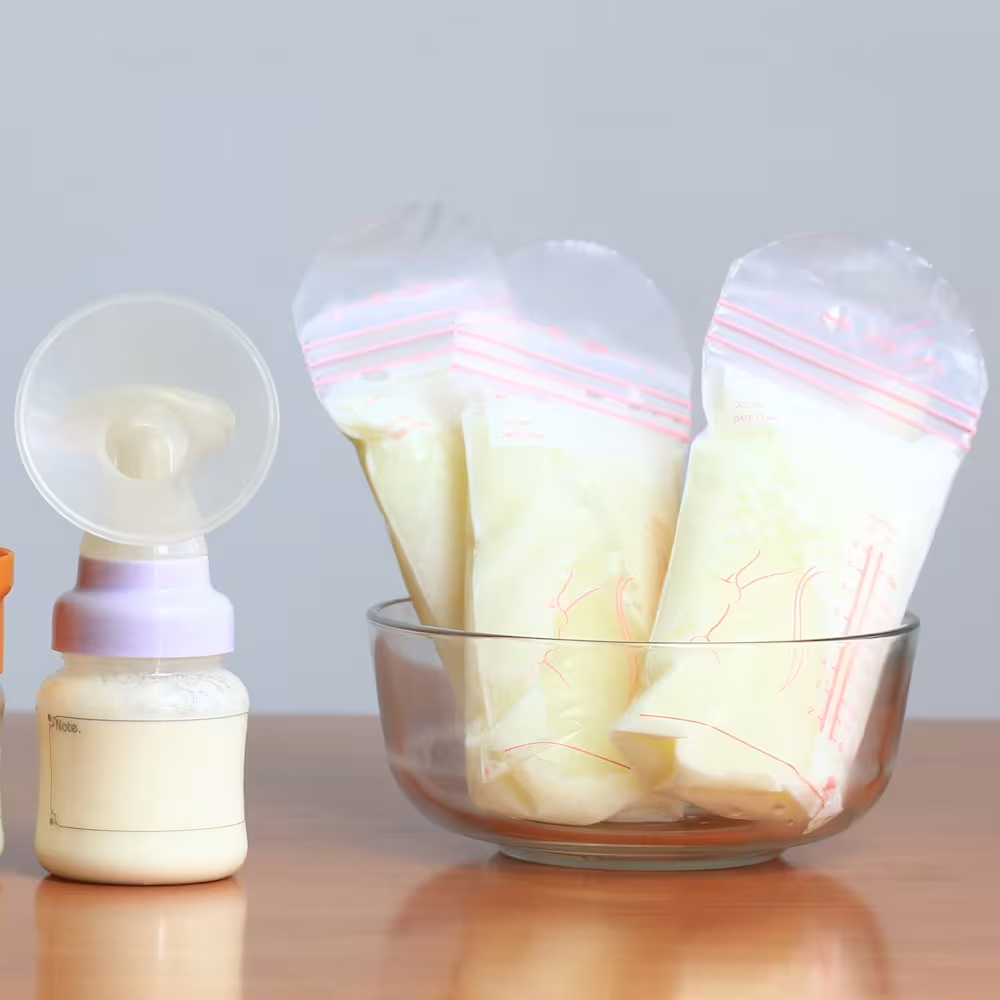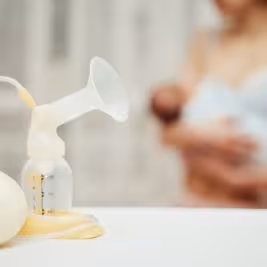Breast pain after pumping: Causes and duration
Updated Oct 17, 2025

If you're breastfeeding, you likely know the familiar hum and slight tug that comes along with a trusty . However, whether you're using a commercial-grade breast pump or a portable device, pumping breast milk shouldn't be painful. It may not be the most glamorous experience, but pumping shouldn't be uncomfortable long-term. If you are feeling during or after pumping, here's what may be causing the discomfort and how you can help treat it.
Table of Contents
Is it normal to experience breast pain after pumping?
It's normal to feel some sensitivity during the first few weeks of breastfeeding as your nipples adjust to your baby’s sucking []. And the same can be said if you're pumping – from the start – as your body gets used to it.
It's also expected to experience fleeting nipple discomfort at the start of each pumping session, even after those initial weeks of breastfeeding. Some pumpers may feel brief pain [] or tenderness — lasting only 10 - 15 seconds — each time they begin pumping as the collagen fibers in their nipples stretch. Some also describe an uncomfortable feeling during letdown as “tingling” or "pins and needles," that quickly subsides.
However, if pumping hurts after the first 2 minutes of each session, it may indicate an underlying problem. Consider talking to your lactation consultant or doctor about any questions and if you have pain that isn’t improving, your nipples are cracked or damaged, or if pumping was pain-free but now there’s a new onset of discomfort [].
What causes breast pain after pumping?
There are two main causes [] of breast pain after pumping: poorly fitting flanges and incorrectly using the breast pump. But there are many reasons why you might experience breast pain during or after pumping. Let’s take a closer look:
Wrong flange size
Even if your pump comes with a set of flanges (most do!), they typically aren't a "one-size-fits-all" type of product. Pumping with the wrong flange size [] may cause pain or tissue damage and impact your milk supply.
Signs the flange is too small:
The sides of your nipple rub along the tunnel
The friction makes pumping painful, even on low settings
Your nipple looks red, purple, or white after pumping
Milk flow is slower or output is less than expected during a pumping session
Signs the flange is too big:
Your areola is pulled into the flange tunnel
It's difficult to get a good seal with the flange during pumping (milk can sometimes be seen around the areola while pumping)
Pumping is painful, even on low settings
You pump less milk than expected during a pumping session
For the right fit, your nipple should be able to move freely in the flange tunnel — without your nipple rubbing or having too much extra space around it. Your breasts should feel fully drained by the time you're done pumping and should feel pain-free, both, during and after your session.
You may need a different flange size for each nipple, and your flange size can change during your breastfeeding/pumping journey. A lactation consultant can measure your nipples and help ensure you have the right fit. There are also a variety of “nipple rulers” you can purchase to help determine which flange size is best.
Improper flange placement
When you pump, your nipple should sit directly in the center of your flange. Even if you're using the correct size, it's easy to accidentally place the flange off-center, which may lead to your nipple rubbing along the side. If this happens, you may end up with nipple pain or damage from the friction. A good way to remedy this is: each time you start pumping, peek down to make sure that your nipples are centered as they move in the tunnel and adjust as necessary.
Incorrect pumping technique (settings or time)
Nipple pain during or after pumping may indicate a problem with your pumping technique. You may have the pump suction too high or be pumping too long. Try reducing pumping time and/or lowering the pump suction to a lower setting and see if that helps with your discomfort. Pumping with a suction setting that's too powerful may cause nipple damage and indirectly impact your supply. Instead of being able to express more milk with the extra power, you may end up with less milk output due to pain and stress, which may lead to only being able to pump for a short time.
Dry, chafed skin
Personal care products, including soaps, lotions, and creams with harsh ingredients, can dry out nipples. Use gentle soap to wash your body and stick to just water [] for your nipples (soap can dry them out, too). Even if you're using the right size flange, you may still experience some nipple chafing as your body adjusts to pumping, especially if you have dry or chapped skin. Lubricating your nipples with a few drops of coconut or other food-grade oils before you start pumping may help prevent chafing.
Nipple vasospasm
Nipple vasospasms [] are bouts of deep breast and sharp nipple pain that can happen whether you breastfeed or pump. They are often associated with Raynaud's phenomenon of the nipple []. During vasospasms, your capillaries temporarily constrict, reducing blood flow, and you may notice your nipples change color and burn or itch [6]. The pain may come and go during or after pumping. Cold air and emotional stress can make these episodes worse. Although more research is needed to determine how common vasospasms are [], one study found that nearly a quarter of new moms experienced vasospasms within the first eight weeks of baby's birth.
Engorgement
Engorgement happens when breast milk isn’t fully drained [] from the breast and the it becomes uncomfortably full. This can make it harder for your baby to latch. You may notice tenderness, swelling, and pressure, which can temporarily flatten your nipples. In some cases, you might also experience sweating, fever, or chills due to inflammation [] (similar to mastitis symptoms).
Although it’s common to become engorged after giving birth as your milk transitions from colostrum to mature milk, it can happen at any time during your breastfeeding/pumping journey.
You may feel engorged when there’s a sudden change in your pumping or feeding schedule (e.g. you’re weaning, skip a few pumping sessions, or your baby drops night feeds) and it can lead to clogged ducts.
Clogged ducts (milk bleb or blister)
With clogged milk ducts, you may experience pain during or after pumping, especially if you aren’t able to properly drain your breasts. You may also notice a milk bleb or blister [] on your nipple. These “dots” may be white, yellow, or clear and are often very painful. Although it looks like a small pimple on the skin, a milk bleb indicates inflammation within your milk ducts. If left untreated, a clogged duct may lead to mastitis (and additional pain).
Mastitis or abscess
Mastitis is typically painful all around — including before, during, and after pumping. You may develop mastitis for multiple reasons, including your breasts not draining thoroughly due to incorrect flange size or pump setting. If left untreated, this infection could lead to an abscess [].
Thrush
Thrush is a fungal infection that may cause shooting breast pain during and after pumping. With thrush [], you may also experience other uncomfortable symptoms, including cracked, itching, flaking, or burning nipples. Thrush may also look like “bright pink” or red nipples.
If your nipple starts itching, flaking, burning, or are cracked and bright pink or red, these may be signs of thrush [](a fungal yeast infection). You may also notice white patches in your baby’s mouth with thrush. Once thrush is treated, your sore nipples should start to heal, and pumping discomfort should improve.
Should I stop pumping if I have breast pain?
If you're experiencing breast pain during or after a pumping session, and it doesn't improve within the first two minutes, ensure your flange is placed correctly with your nipple in the center (and not rubbing along the side of the tunnel). Also consider adjusting your pump settings to reduce the vacuum to see if that resolves the pain. If you rule out these sources of discomfort, we recommend pausing your pumping session. Assess if your breasts are too full to obtain a good seal with the flange or if you have any cracks or blisters on your nipple. If everything appears ok, attempt to continue pumping. Should pain persist, consider hand expressing your milk while you get in contact with a lactation consultant. When it comes to prolonged pain and the decision to continue regularly pumping or taking a break from the pump, this is often a delicate balance. On one hand, you don't want to create more nipple damage if the problem is leading to friction (e.g. from an incorrect flange size, dry skin, or incorrect breast pump use). But you also don't want to potentially exacerbate other issues (like clogged ducts or lowering your supply) by limiting your pumping sessions. For breast pain that doesn't improve, check with a lactation consultant or healthcare provider for the next steps and a pumping plan that's right for you.
How long does breast pain last after pumping?
Breastfeeding and/or pumping may be uncomfortable for the first week or two after birth. If the sensitivity doesn't improve by the second week or you're experiencing new or worsening breast pain, it may indicate an underlying issue. The fix may be as simple as adjusting your flange placement or changing your pump setting to find immediate relief. However, breast pain may last after pumping and take longer to heal depending on the extent of any tissue damage and how long it takes to treat the underlying cause.
How can I help prevent breast pain before pumping?
Check flange placement (nipple should sit directly in the center of your flange)
Be mindful of your pump suction setting (if it’s too high, it may cause pain or damage)
Make sure your pump flanges are the right size
Lubricate your nipples before pumping with coconut oil or another food-grade oil
Try heat with a warm shower or compress before pumping to help get milk flowing (but keep nipples dry if you have a yeast infection) []
Consider taking sunflower lecithin [], which can reduce the stickiness of milk fat; contact your healthcare provider for dosage recommendations
How can I relieve breast pain during or after pumping?
Double-check flange placement
Adjust your pump settings
After pumping, express a little breast milk on your nipples or apply lanolin cream
Use ice after pumping to help reduce inflammation
Gently massage your breast
Take ibuprofen and/or acetaminophen to help with swelling
Try using a breast shell or silver nursing cups
Speak to a lactation consultant or healthcare professional
When to seek professional advice
It’s normal to have some sensitivity when initially breastfeeding or pumping. But if you have new or worsening breast pain or discomfort that doesn’t improve over the first two weeks of nursing, speak to your lactation consultant or doctor. But don’t hesitate to reach out with any questions before then. If your nipples are cracked or bleeding, you’re at an increased risk for infection, so the sooner you get help, the better.
Other signs you may want to seek help include:
Pumping hurts after the first 2 minutes of each session
Post-pumping pain continues past the first 2 weeks
It's also important to consult a healthcare professional as soon as possible if you experience symptoms of a persistent clogged duct, mastitis, or thrush. These include:
Breast redness, irritation, or red streaking pattern
Body aches
Feeling sick or like you have the flu
Fever
Hot flashes
Breast that is hot to the touch
Dense breast lumps (or clogged milk ducts)
A milk bleb (a small, white or yellowish spot on the nipple)
Previously pain-free nipples become cracked, itchy, burning, bright pink, red, shiny, flaky, rashy, or blistery
Takeaway
Although some breast tenderness and nipple sensitivity are normal initially (both when you start breastfeeding and during individual pumping sessions), generally speaking, pumping breast milk shouldn't be painful.
If you experience new or prolonged breast pain (that doesn’t improve after the first 2 weeks or after the initial 2 minutes of each session), there may be an underlying cause.
You may experience breast pain before or after pumping for multiple reasons, including using the wrong size flange, improper flange placement, problems with your pump technique, dry skin, nipple vasospasm, engorgement, clogged ducts, mastitis, and thrush.
The amount of time it takes for breast pain to subside after pumping depends on why it’s happening. As you determine the cause and treat it, there are things you can also try to help soothe the pain, including lubricating your nipples with coconut oil, expressed breast milk, or lanolin cream. Also consider applying ice and taking ibuprofen and/or acetaminophen to help with swelling.
Contact a medical provider or lactation consultant with any questions or concerns and if you need help with flange sizing or pump settings, have cracked or bleeding nipples, persistent pain that doesn't improve, symptoms of thrush, or signs of mastitis.
Breast pain after pumping FAQs
- You're pumping with a flange that's the wrong size or isn't centered and the prolonged friction causes damage to the nipple tissue. The wrong size flange may also prevent your breast from draining properly, which may lead to issues like engorgement or clogged ducts. Pumping too much can unintentionally create an oversupply of breast milk leading to engorgement.
- You have dry or chapped nipples and didn’t lubricate them before pumping.
- Your pump suction setting is too high, but you continue pumping without adjusting it, despite the pain.
Share article:
Note: The content on this site is for informational purposes only and should not replace medical advice from your doctor, pediatrician, or medical professional. If you have questions or concerns, you should contact a medical professional.
15 Sources
Table of Contents
Share article:




